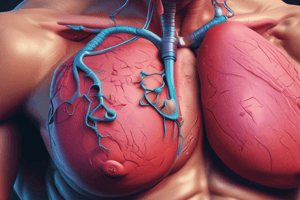Podcast
Questions and Answers
A flail chest occurs when:
A flail chest occurs when:
- Multiple ribs are fractured on both sides of the thoracic cage.
- A segment of the chest wall is detached from the thoracic cage. (correct)
- A segment of fractured ribs bulges during the inhalation phase.
- More than three ribs are fractured on the same side of the chest.
If a patient with a chest injury is only able to inhale small amounts of air per breath, he or she:
If a patient with a chest injury is only able to inhale small amounts of air per breath, he or she:
- Often breathes at a slower rate because of lung damage caused by the injury.
- Will eliminate more carbon dioxide than if he or she were breathing deeply.
- Will maintain adequate minute volume if his or her respiratory rate stays the same.
- Must increase his or her respiratory rate to maintain adequate minute volume. (correct)
While jogging, a 19-year-old male experienced an acute onset of shortness of breath and pleuritic chest pain. You should:
While jogging, a 19-year-old male experienced an acute onset of shortness of breath and pleuritic chest pain. You should:
- Immediately perform a rapid head-to-toe exam.
- Administer oxygen and transport to the hospital. (correct)
- Recognize that he needs a needle decompression.
- Circumferentially tape a dressing around his chest.
A simple pneumothorax:
A simple pneumothorax:
Which of the following is NOT a sign or symptom of a chest injury?
Which of the following is NOT a sign or symptom of a chest injury?
On inhalation, which of the following does NOT occur?
On inhalation, which of the following does NOT occur?
The thoracic cavity is separated from the abdominal cavity by the:
The thoracic cavity is separated from the abdominal cavity by the:
You should be MOST suspicious that the 50-year-old female patient from a motor vehicle crash has experienced a:
You should be MOST suspicious that the 50-year-old female patient from a motor vehicle crash has experienced a:
After sealing the open chest wound of a 40-year-old male who was stabbed, you should:
After sealing the open chest wound of a 40-year-old male who was stabbed, you should:
Which of the following is Not a pertinent negative to note during your assessment of a patient with chest trauma?
Which of the following is Not a pertinent negative to note during your assessment of a patient with chest trauma?
Which of the following is most likely to cause immediate death?
Which of the following is most likely to cause immediate death?
Immediately life-threatening chest injuries must be found and managed during the ______.
Immediately life-threatening chest injuries must be found and managed during the ______.
Flashcards are hidden until you start studying
Study Notes
Flail Chest and Respiratory Mechanics
- A flail chest occurs when multiple ribs are fractured on both sides or when a segment of the chest wall detaches from the thoracic cage.
- Patients with chest injuries who can only inhale small amounts must increase their respiratory rate to maintain adequate minute volume.
Assessment and Management of Chest Injuries
- Diminished breath sounds on one side, combined with pleuritic chest pain, necessitates administering oxygen and transporting the patient to a hospital.
- Simple pneumothorax is typically caused by blunt chest trauma and can heal without treatment.
Signs and Symptoms of Chest Injuries
- Clear and equal breath sounds are not indicative of chest injury.
- Common signs of chest injury include unequal chest expansion, bruising of the chest wall, and crepitus upon palpation.
Inhalation Process
- During inhalation, air enters through the nose and mouth, the diaphragm contracts, and intercostal muscles elevate the rib cage; pressure inside the chest decreases, not increases.
Anatomy and Complications
- The diaphragm separates the thoracic cavity from the abdominal cavity.
- In a motor vehicle crash, signs such as being unresponsive and tachycardic with clear breath sounds suggest possible aortic laceration.
Management of Open Chest Wounds
- If a patient with an open chest wound shows respiratory distress after sealing the wound, the dressing should be partially removed.
- Pertinent negatives during the assessment exclude areas of deformity, associated shortness of breath, and rapid breathing, but not heart murmurs.
Immediate Threats and Assessments
- Aortic rupture is most likely to cause immediate death among chest injuries.
- Life-threatening injuries should be identified during the primary assessment stage.
Special Cases and Emergency Responses
- Care for a semi-conscious patient with severe breathing difficulties, jugular venous distention, and absent breath sounds involves immediate ventilation support and requesting advanced life support.
Studying That Suits You
Use AI to generate personalized quizzes and flashcards to suit your learning preferences.



